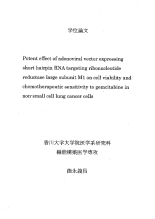Potent effect of adenoviral vector expressing short hairpin RNA targeting ribonucleotide reductase large subunit M1 on cell viability and chemotherapeutic sensitivity to gemcitabine in non-small cell lung cancer cells
この論文にアクセスする
著者
書誌事項
- タイトル
-
Potent effect of adenoviral vector expressing short hairpin RNA targeting ribonucleotide reductase large subunit M1 on cell viability and chemotherapeutic sensitivity to gemcitabine in non-small cell lung cancer cells
- 著者名
-
徳永, 義昌
- 学位授与大学
-
香川大学
- 取得学位
-
博士(医学)
- 学位授与番号
-
甲第621号
- 学位授与年月日
-
2016-03-24
注記・抄録
Background: Ribonucleotide reductase large subunit (RRM1) is the main enzyme responsible for synthesis of the deoxyribonucleotides used during DNA synthesis. It is also a cellular target for gemcitabine (GEM). Overexpression of RRM1 is reportedly associated with resistance to GEM and the poor prognosis for many types of malignant tumours. Aim of the present study is to establish gene therapy against RRM1-overexpressing tumours.
Method: An adenoviral vector that encoded a short hairpin siRNA targeting the RRM1 gene (Ad-shRRM1) was constructed. Two RRM1-overexpressing non-small cell lung cancer (NSCLC) lines, MAC10 and RERF-LC-MA, were used. Finally, a human tumour xenograft model in nude mice was prepared by subcutaneously implanting tumours derived from RERF-LC-MA cells.
Results: Ad-shRRM1 effectively downregulated RRM1 mRNA and protein in both types of NSCLC cells and significantly reduced the percentage of viable cells as detected by 3-(4,5-dimethylthiazol-2-yl)-2,5-diphenyltetrazolium bromide (MTT) assay (p<0.005). Caspase 3/7 analysis revealed that transfection with Ad-RRM1 increased the percentage of apoptotic cells in culture containing either type of RRM1-overexpressing cell (p<0.001). Treatment with Ad-shRRM1 exerted a potent antitumour effect against the RRM1-overexpressing RERF-LC-MA xenografts (p<0.05). Furthermore, Ad-shRRM1-mediated inhibition of RRM1 specifically increased sensitivity to gemcitabine of each type of RRM1-overexpressing tumour cell. Combination treatment with Ad-shRRM1 and GEM exerted significantly greater inhibition on cell proliferation than Ad-shRRM1 or GEM treatment alone.
Conclusion: RRM1 appeared to be a promising target for gene therapy, and Ad-shRRM1 had strong antitumour effects, specifically anti-proliferative and pro-apoptotic effects, against NSCLC cells that overexpressed RRM1. Combination therapy with Ad-shRRM1 and GEM may become a new treatment option for patients with NSCLC.

